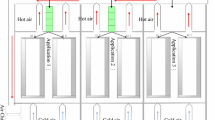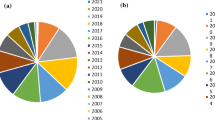Abstract
The increasing demand for faster computing and high storage capacity has resulted in an increase in energy consumption and heat generation in datacenters. Because of the increase in heat generation, cooling requirements have become a critical concern, both in terms of growing operating costs as well as their environmental and societal impacts. Presently, thermal management techniques make an effort to thermally profile and control datacenters’ cooling equipment to increase their efficiency. In conventional thermal management techniques, cooling systems are triggered by the temperature crossing predefined thresholds. Such reactive approaches result in delayed response as the temperature may already be too high, which can result in performance degradation of hardware.
In this work, a proactive control approach is proposed that jointly optimizes the air conditioner compressor duty cycle and fan speed to prevent heat imbalance—the difference between the heat generated and extracted from a machine—thus minimizing the cost of cooling. The proposed proactive optimization framework has two objectives: (i) minimize the energy consumption of the cooling system, and (ii) minimize the risk of equipment damage due to overheating. Through thorough simulations comparing the proposed proactive heat-imbalance estimation-based approach against conventional reactive temperature-based schemes, the superiority of the proposed approach is highlighted in terms of cooling energy, response time, and equipment failure risk.
Similar content being viewed by others
References
Advanced configuration & power interface (acpi). Technical report, 2009
ASHRAE Technical Committees (2004) Thermal guidelines for data processing environments. American Society of Heating, Refrigerating and Air-Conditioning Engineers (ASHRAE)
Beitelmal AH, Patel CD (2007) Computational fluid dynamics modeling of high compute density data centers to assure system inlet air specifications. Distrib Parallel Databases 21(2–3):227–238
Cameron KW, Ge R, Feng X (2005) High-performance, power-aware distributed computing for scientific applications. Computer 38(11):40–47
Chandra G, Kapur P, Saraswat KC (2002) Scaling trends for the on chip power dissipation. In: Proc of IEEE interconnect technology conference (IITC), Burlingame, CA, June 2002, pp 170–172
EPA (2007) EPA report to congress on server and data center energy efficiency. Technical report, US Environmental Protection Agency
Greenberg S, Mills E, Tschudi B (2006) Best practices for data centers: lessons learned from benchmarking 22 data centers. In: Proc of American council for an energy-efficient economy (ACEEE), Pacific Grove, CA, August 2006
Hayama H, Nakao M (1989) Air flow systems for telecommunications equipment rooms. In: International telecommunications energy conference (INTELEC), Florence, Italy, October 1989
Hayama H, Nakao M (1990) Airflow distribution in telecommunications equipment rooms. In: International telecommunications energy conference (INTELEC), Orlando, FL, October 1990
Heath T, Centeno AP, George P, Ramos L, Jaluria Y, Bianchini R (2006) Mercury and freon: temperature emulation and management for server systems. In: Proc of the architectural support for programming languages and operating systems (ASPLOS-XII), San Jose, California, October 2006, pp 106–116
Hsu C, Feng Wu, Archuleta JS (2005) Towards efficient supercomputing: a quest for the right metric. In: Proc of IEEE international parallel and distributed processing symposium (IPDPS), Denver, Colorado, April 2005
Kang S, Schmidt RR, Kelkar K, Patankar S (2001) A methodology for the design of perforated tiles in raised floor data centers using computational flow analysis. IEEE Trans Compon Packag Technol 24(2):177–183
Khan SU, Ahmad I (2009) A cooperative game theoretical technique for joint optimization of energy consumption and response time in computational grids. IEEE Trans Parallel Distrib Syst 20(3):346–360
Liu Y, Zhu H (2009) A survey of the research on power management techniques for high-performance systems. Softw Pract Exp
Moore J, Chase J, Ranganathan P, Sharma R (2005) Making scheduling “cool”: temperature-aware workload placement in data centers. In: Proc of annual conference on USENIX annual technical conference (ATEC), Anaheim, CA, April 2005, p 5
Mukherjee T, Banerjee A, Varsamopoulos G, Gupta SKS, Rungta S (2009) Spatio-temporal thermal-aware job scheduling to minimize energy consumption in virtualized heterogeneous data centers. Comput Netw 53(17):2888–2904
Nakao M, Hayama H, Nishioka M (1991) Which cooling air supply system is better for a high heat density room: underfloor or overhead? In: Proc of international telecommunications energy conference (INTELEC), Kyoto, Japan, November 1991
Patel C, Bash C, Belady L, Stahl L, Sullivan D (2001) Computational fluid dynamics modeling of high compute density data centers to assure system inlet air specifications. In: Proc of pacific Rim/ASME international electronic packaging technical conference of (IPACK), Kauai, HI, August 2001
PGnE (2006) High performance data centers: a design guidelines sourcebook. http://hightech.lbl.gov/documents/data_centers/06_datacenters-pge.pdf
Rambo J, Joshi Y (2007) Modeling of data center airflow and heat transfer: state of the art and future trends. Distrib Parallel Databases 21(2–3):193–225
Schmidt RR (2004) Thermal profile of a high-density data center-methodology to thermally characterize a data center. Trans Am Soc Heat Refrig Air-Cond Eng (ASHRAE) 110(2):635–642
Schmidt RR, Cruz E (2002) Raised floor computer data center: effect on rack inlet temperatures of exiting both the hot and cold aisle. In: Proc of intersociety conference on thermal phenomena in electronic systems (ITHERM), San Diego, CA, August 2002
Schmidt RR, Karki K, Kelkar K, Radmehr A, Patankar S (2001) Measurements and predictions of the flow distribution through perforated tiles in raised floor data centers. In: Proc of pacific Rim/ASME international electronic packaging technical conference of (IPACK), Kauai, HI, August 2001
Schmidt RR, Karki KC, Patankar SV (2004) Raised floor computer data center: perforated tile flow rates for various tile layouts. In: Proc of intersociety conference on thermal phenomena in electronic systems (ITHERM), Las Vegas, NV, June 2004
Schmidt RR, Cruz EE, Iyengar MK (2005) Challenges of data center thermal management. IBM J Res Dev 49(4/5):709–723
Shan AJ, Krishnan N (1989) Flow resistance: a design guide for engineers. Hemisphere, Washington
Sharma RK, Bash CE, Patel RD (2002) Dimensionless parameters for evaluation of thermal design and performance of large-scale data centers. In: Proc of ASME/AIAA joint thermophysics and heat transfer conference, St. Louis, MO, June 2002
Srinivasan J, Adve SV, Bose P, Rivers JA (2004) The impact of technology scaling on lifetime reliability. In: Proc of the international conference on dependable systems and networks (DSN), Washington, DC, 2004. IEEE Computer Society, Washington, p 177
Subrata R, Zomaya AY, Landfeldt B (2010) Cooperative power-aware scheduling in grid computing environments. J Parallel Distrib Comput 70(2):84–91
Author information
Authors and Affiliations
Corresponding author
Rights and permissions
About this article
Cite this article
Lee, E.K., Kulkarni, I., Pompili, D. et al. Proactive thermal management in green datacenters. J Supercomput 60, 165–195 (2012). https://doi.org/10.1007/s11227-010-0453-8
Published:
Issue Date:
DOI: https://doi.org/10.1007/s11227-010-0453-8




